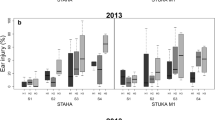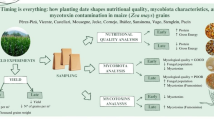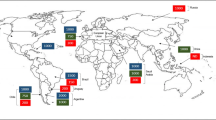Abstract
Artificial drying, although costly, ensures a safe storage and preserves post-harvest grain quality. Alternatively, a more cost-effective measure is to delay harvest to promote natural drying, but this management may increase the risk of mycotoxigenic ear rot fungi contamination. The objective was to evaluate the effect of increasing maize harvest delay on fungal disease and fumonisin levels. Three maize hybrids (BRS1035, Attack and DKB390 YG) were sown in the field to study the effect of five harvest delays (15, 30, 45, 60 and 75 days) after the optimum date (18% grain moisture). There was a significant trend of increasing the incidence of kernel rot and total fumonisins in the grains when delaying harvest, but fungal incidence and mycotoxin contamination varied with the hybrid. The main fungi detected in the grain samples were Fusarium verticillioides and Stenocarpella maydis. The hybrid DKB390 YG showed significantly lower incidence of F. verticillioides contamination and lower fumonisin accumulation in the grains than the other hybrids. The hybrid Attack was the least susceptible to kernel rot incidence. Our data shows that delaying harvest for minimizing drying costs may increase the risk of mycotoxin contamination in maize in the tropics of Brazil.


Similar content being viewed by others
References
Alves WM, Faroni LRA, Corrêa PC, Queiroz DM, Teixeira MM (2001) Influência dos teores de umidade de colheita na qualidade do milho (Zea mays L.) durante o armazenamento. Revista Brasileira de Armazenamento 26:40–45
Arino A, Juan T, Estopanan G, Gonzalez-Cabo JF (2007) Natural occurrence of Fusarium species, fumonisin production by toxigenic strains, and concentrations of fumonisins B1 and B2 in conventional and organic maize grown in Spain. Journal of Food Protection 70:151–156
Bakan B, Melcion D, Richard-Molard D, Cahagnier B (2002) Fungal growth and Fusarium mycotoxin content in isogenic traditional maize and genetically modified maize grown in France and Spain. Journal of Agricultural and Food Chemistry 50:728–731
Blandino M, Reyneri A, Colombari G, Pietri A (2009) Comparison of integrated field programmes for the reduction of fumonisin contamination in maize kernels. Field Crops Research 111:284–289
Bowers E, Hellmich R, Munkvold G (2013) Vip3Aa and Cry1Ab proteins in maize reduce Fusarium ear rot and fumonisins by deterring kernel injury from multiple Lepidopteran pests. World Mycotoxin Journal 6:127–135
Bruns HA, Abbas HK (2004) Effects of harvest date on maize in the humid sub-tropical mid-South USA. Maydica 49:1–7
Bush BJ, Carson ML, Cubeta MA, Hagler WM, Payne GA (2004) Infection and fumonisin production by Fusarium verticillioides in developing maize kernels. Phytopathology 94:88–93
Butron A, Santiago R, Mansilla P, Pintos-Varela C, Ordas A, Malvar RA (2006) Maize (Zea mays L.) genetic factors for preventing fumonisin contamination. Journal of Agricultural and Food Chemistry 54:6113–6117
Cao A, Santiago R, Ramos AJ, Marín S, Reid LM, Butrón A (2013) Environmental factors related to fungal infection and fumonisin accumulation during the development and drying of white maize kernels. International Journal of Food Microbiology 164:15–22
Chulze SN, Ramirez ML, Farnochi MC, Pascale M, Visconti A, March G (1996) Fusarium and Fumonisin occurrence in Argentinian corn at different ear maturity stages. Journal of Agricultural and Food Chemistry 44:2797–2801
Cruz JC, Garcia JC, Filho IAP, Luciano BBP, Luciano RQ (2009) Caracterização dos sistemas de produção de milho para altas produtividades. Embrapa Milho e Sorgo. Circular Técnica 124:2009
De la Campa R, Hooker DC, Miller JD, Schaafsma AW, Hammond BG (2005) Modelling effects of environment, insect damage, and Bt genotypes on fumonisin accumulation in maize in Argentina and the Philippines. Mycopathologia 159:539–552
Dowd PF (2000) Indirect reduction of ear molds and associated mycotoxins in Bacillus thuringiensis corn under controlled and open field conditions: utility and limitation. Journal of Economic Entomology 93:1669–1679
Fandohan P, Gnonlonfin B, Hell K, Marasas WF, Wingfield MJ (2005) Natural occurrence of Fusarium and subsequent fumonisin contamination in preharvest and stored maize in Benin, West Africa. International Journal of Food Microbiology 99:173–183
Ferreira DF (2011) Sisvar: a computer statistical analysis system. Ciência e Agrotecnologia 35:1039–1042
Ferreira LVH, Omori AM, Bordini JG, Hirozawa MT, Hirooka EY, Ono EYS (2016) Efeito do sistema de plantio e da fertilização nitrogenada na contaminação de milho por fumonisinas. Biosaúde 18:27–36
Folcher L, Delos M, Jarry M, Weissenberger A, Eychenne N, Regnault-Roger C (2010) Lower mycotoxin levels in Bt maize grain. Agronomy for Sustainable Development 30:711–719
Guo C, Liu Y, Jiang Y, Li R, Pang M, Liu Y, Dong J (2016) Fusarium species identification and fumonisin production in maize kernels from Shandong Province, China, from 2012 to 2014. Food Additives & Contaminants 9:203–209
Headrick JM, Pataky JK, Juvik JA (1990) Relationships among carbohydrate content of kernels, condition of silks after pollination, and the response of sweet corn inbred lines to infection of kernels by Fusarium moniliforme. Phytopathology 80:487–494
Hermanns G, Pinto FT, Kitazawa SE, Noll IB (2006) Fungos e fumonisinas no período pré-colheita do milho. Ciência e Tecnologia de Alimentos 26:7–10
Herrera M, Conchello P, Juan T, Estopañán G, Herrera A, Ariño A (2010) Fumonisins concentrations in maize as affected by physico-chemical, environmental and agronomical conditions. Maydica 5:121–126
Jackson L, Jablonski J (2004) Fumonisins. In: Magan N, Olsen M (eds) Mycotoxins in food. Wood-head Publishing Ltd. and CRC Press LLC, Cambridge, pp 384–422
Johnson LA (2000) Corn: the major cereal of the Americas. In: Kulp K, Ponte JG (eds) Handbook of cereal science and technology. Mercel Dekker, New York, pp 33–34
Kaaya AN, Warren HL, Kyamanywa S, Kyamuhangire W (2005) The effect of delayed harvest on moisture content, insect damage, moulds and aflatoxin contamination of maize in Mayuge district of Uganda. Journal of the Science of Food and Agriculture 85:2595–2599
Kamala A, Kimanya M, Haesaert G, Tiisekwa B, Madege R, Degraeve S, Cyprian C, Meulenaer B (2016) Local post-harvest practices associated with aflatoxin and fumonisin contamination of maize in three agro ecological zones of Tanzania. Food Additives and Contaminants 33:551–559
Kedera CJ, Leslie JF, Claflin LE (1992) Systemic infection of corn by Fusarium moniliforme. Phytopathology 82:1138
King S (1981) Time of infection of maize kernels by Fusarium moniliforme and Cephalosporium acremonium. Phytopathology 71:796–799
Lanza FE, Zambolim L, da Costa RV, da Silva DD, Queiroz VAV, Parreira DF, Mendes SM, Souza AGC, Cota LV (2016) Aplicação foliar de fungicidas e incidência de grãos ardidos e fumonisinas totais em milho. Pesquisa Agropecuária Brasileira 51:638–646
Lanza FE, Zambolim L, Costa RV, Figueiredo JEF, Silva DD, Queiroz VAV, Guimarães EA, Cota LV (2017) Symptomatological aspects associated with fungal incidence and fumonisin levels in corn kernels. Tropical Plant Pathology 42:304–308
Lauren DR, Smith WA, Di Menna ME (2007) Influence of harvest date and hybrid on the mycotoxin content of maize (Zea mays) grain grown in New Zealand. New Zealand Journal of Crop and Horticultural Science 35:331–340
Lerda D (2017) Fumonisins in foods from Cordoba (Argentina), presence: mini review. Toxicology Open Access 3:125
Leslie JF, Summerell BA, Bullock S (2006) The Fusarium laboratory manual. Wiley-Blackwell, Oxford, p 388
Marasas WF (2001) Discovery and occurrence of the Fumonisins: a historical perspective. Environmental Health Perspectives 109:239–243
Marques OJ, Vidigal Filho OS, Dalpasquale VA, Scapim CA, Pricinotto LF, Machinski Junior M (2009) Incidência fúngica e contaminações por micotoxinas em grãos de híbridos comerciais de milho em função da umidade de colheita. Acta Scientiarum Agronomy 31:667–675
Miller JD (1994) Epidemiology of Fusarium ear diseases of cereals. In: Miller JD, Trenholm HL (eds) Mycotoxins in grain. Compounds other than aflatoxin. Eagan Press, St Paul, pp 19–36
Munkvold GP, McGee DC, Carlton WM (1997) Importance of different pathways for maize kernel infection by Fusarium moniliforme. Phytopathology 87:209–217
Munkvold GP, Hellmich RL, Rice LG (1999) Comparison of fumonisin concentrations in kernels of transgenic Bt maize hybrids and nontransgenic hybrids. Plant Disease 83:130–138
Nelson PE, Plattner RD, Shackelford DD, Desjardins AE (1991) Production of fumonisins by Fusarium moniliforme strains from various substrates and geographic areas. Applied and Environmental Microbiology 57:2410–2412
Parsons MW, Munkvold GP (2010) Associations of planting date, drought stress, and insects with Fusarium ear rot and fumonisin B1 contamination in California maize. Food Additives & Contaminants 27:591–607
Pascale MA, Visconti A, Pronczuk M, Wisniewska H, Chelkowski J (1997) Accumulation of fumonisins in maize hybrids inoculated under field conditions with Fusarium moniliforme Sheldon. Journal of the Science of Food and Agriculture 74:1–6
Samapundo S, De Meulenaer B, De Muer N, Debevere J, Devlieghere F (2006) Influence of experimental parameters on the fluorescence response and recovery of the high-performance liquid chromatography analysis of Fumonisin B1. Journal of Chromatography 1109:312–316
Santiago R, Cao A, Butrón A (2015) Genetic factors involved in fumonisin accumulation in maize kernels and their implications in maize agronomic management and breeding. Toxins 7:3267–3296
Santin JA, Reis EM, Matsumura ATS, Moraes MG (2004) Efeito do retardamento da colheita de milho na incidência de grãos ardidos e de fungos patogênicos. Revista Brasileira de Milho e Sorgo 3:182–192
Shelby RA, White DG, Bauske EM (1994) Differential fumonisin production in maize hybrids. Plant Disease 78:582–584
Sobek EA, Munkvold GP (1999) European corn borer (Lepidoptera: Pyralidae) larvae as vectors of Fusarium moniliforme, causing kernel rot and symptomless infection of maize kernels. Ecological Entomology 92:503–509
Sutton BC (1980) The coelomycetes. Commonwealth Mycological Institute, Kew, Surrey, England. 696p
Torelli E, Firrao G, Bianchi G, Saccardo F, Locci R (2012) The influence of local factors on the prediction of fumonisin contamination in maize. Journal of the Science of Food and Agriculture 92:1808–1814
Warfield CY, Gilchrist DG (1999) Influence of kernel age on Fumonisin B1 production in maize by Fusarium moniliforme. Environmental Microbiology 65:2853
Yılmaz N, Tuncel NB (2010) An alternative strategy for corn drying (Zea mays) resulted in both energy savings and reduction of fumonisins B1 and B2 contamination. International Journal of Food Science & Technology 45:621–628
Acknowledgements
The authors thank the Embrapa Maize and Sorghum and National Council for Scientific and Technological Development (CNPq) for financial support.
Author information
Authors and Affiliations
Corresponding author
Additional information
Section Editor: Raul Allende-Mollar
Rights and permissions
About this article
Cite this article
da Costa, R.V., Queiroz, V.A.V., Cota, L.V. et al. Delaying harvest for naturally drying maize grain increases the risk of kernel rot and fumonisin contamination. Trop. plant pathol. 43, 452–459 (2018). https://doi.org/10.1007/s40858-018-0234-0
Received:
Accepted:
Published:
Issue Date:
DOI: https://doi.org/10.1007/s40858-018-0234-0




